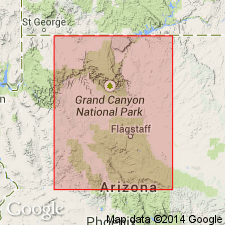
- Usage in publication:
-
- Rampart Cave member
- Modifications:
-
- Original reference
- Biostratigraphic dating
- Dominant lithology:
-
- Limestone
- Dolomite
- Siltstone
- AAPG geologic province:
-
- Plateau sedimentary province
Summary:
Pg. 14 (fig. 1), 19, 84-87. Rampart Cave member of Muav formation. This facies is of uniform character over a wide area, but changes abruptly to the east (dolomite) and south (algal). Consists almost entirely of gray or dark-gray aphanitic limestone with small amount of light-brown or tan silty mottling. Mostly thick-bedded and massive, although thin beds found at top and bottom in many sections. In vicinity of Grand Wash Cliffs, maximum thickness about 160 feet. Thins to the east. Basal subdivision of Muav formation; overlies Flour Sack member (new ) of Bright Angel shale. Age is Middle Cambrian, based on fossils (trilobites) identified by C.E. Resser. Report includes measured sections, cross sections, faunal list.
Type locality not designated. Named from a cavern near base of member, a few mi east of Grand Wash Cliffs on south side of Lake Mead, [Mohave Co., northwestern AZ]. In western half of Grand Canyon.
Source: US geologic names lexicon (USGS Bull. 1200, p. 3195); supplemental information from GNU records (USGS DDS-6; Menlo GNULEX, Denver GNULEX), GNC index card files.
For more information, please contact Nancy Stamm, Geologic Names Committee Secretary.
Asterisk (*) indicates published by U.S. Geological Survey authors.
"No current usage" (†) implies that a name has been abandoned or has fallen into disuse. Former usage and, if known, replacement name given in parentheses ( ).
Slash (/) indicates name conflicts with nomenclatural guidelines (CSN, 1933; ACSN, 1961, 1970; NACSN, 1983, 2005, 2021). May be explained within brackets ([ ]).

